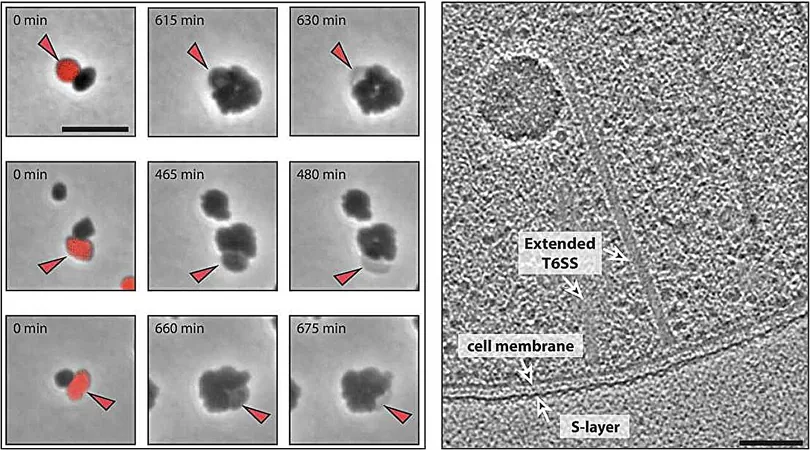
Breakthrough in Graphene Research: Scientists Unveil the Secrets of Fractional Electrons!
2024-11-24
Author: Emma
Exciting Revelation from MIT
In an exciting revelation from the Massachusetts Institute of Technology (MIT), researchers have deepened our understanding of how electrons can divide themselves into fractional charges, particularly in a novel material known as pentalayer graphene—a structure made up of five stacked layers of graphene atop boron nitride. This discovery not only challenges previous beliefs regarding electron behavior but opens the door to groundbreaking experiments and applications in the realm of quantum physics.
Findings of the Previous Research
Previously, a team led by MIT’s Assistant Professor Long Ju reported astonishing findings where electrons within pentalayer graphene demonstrated fractional charge behavior, even without the presence of a strong magnetic field—a phenomenon typically observed only under such conditions, known as the fractional quantum Hall effect. This unexpected behavior was termed the 'fractional quantum anomalous Hall effect.'
The New Study: Unraveling the Mystery
Now, a new study spearheaded by Professor Senthil Todadri has unraveled part of the mystery behind this fractional charge emergence. By analyzing quantum mechanical interactions, Todadri and his team revealed that when an electric current flows through the pentalayer structure, the confined electrons form a unique crystal-like formation, allowing these fractional charges to manifest.
"This is a completely new mechanism," exclaimed Todadri. "In all the years of research in this field, we never had a system capable of exhibiting these fractional electron behaviors. It's thrilling as it paves the way for experiments we could only dream of until now."
MIT's Research Legacy in Graphene
MIT has been at the forefront of groundbreaking research in graphene, particularly with the work of Professor Pablo Jarillo-Herrero, who, back in 2018, demonstrated that stacking and twisting graphene sheets leads to new electronic phenomena. His discovery laid the foundation for the emerging field of twistronics, which studies the unique behaviors of two-dimensional materials when manipulated at specific angles.
Collaboration and New Discoveries
Todadri's collaboration with Ju began when they analyzed experimental data that indicated these fractional behaviors in ways they didn’t anticipate. Initially, Todadri's theoretical work suggested that the electron charge could emerge from a twisting electron wavefunction—yet the actual experiments revealed a different scenario, raising questions about their earlier assumptions.
Realizing that a fundamental element may have been overlooked, Todadri's team shifted their approach. Unlike traditional methods treating electrons as independent entities, they acknowledged that in the confined space of pentalayer graphene, electron interactions were not merely peripheral; they were integral to understanding the physics at play.
Incorporating Inter-Electron Interaction
When they incorporated this inter-electron interaction into their models, they discovered that it accurately predicted the electron behavior observed by Ju. The unique moiré pattern—formed by the layered structure—creates a weak electrical potential, which confines electrons and enhances their interactions. This prompted the emergence of a cloud-like array of potential states for each electron, setting the stage for the fractional charge phenomenon.
Future Implications of the Research
"The remarkable properties of this crystal structure could lead to a wave of new research questions," said Todadri. "In the short term, this work not only clarifies the observations of fractional charges in pentalayer graphene but lays the groundwork for exploring analogous systems."
As this research unfolds, the implications could ripple across materials science, electronics, and quantum computing, ushering in a new era of technological advancements. Don't miss the chance to follow this groundbreaking journey as scientists continue to unveil the mysteries of the quantum realm!









 Brasil (PT)
Brasil (PT)
 Canada (EN)
Canada (EN)
 Chile (ES)
Chile (ES)
 España (ES)
España (ES)
 France (FR)
France (FR)
 Hong Kong (EN)
Hong Kong (EN)
 Italia (IT)
Italia (IT)
 日本 (JA)
日本 (JA)
 Magyarország (HU)
Magyarország (HU)
 Norge (NO)
Norge (NO)
 Polska (PL)
Polska (PL)
 Schweiz (DE)
Schweiz (DE)
 Singapore (EN)
Singapore (EN)
 Sverige (SV)
Sverige (SV)
 Suomi (FI)
Suomi (FI)
 Türkiye (TR)
Türkiye (TR)